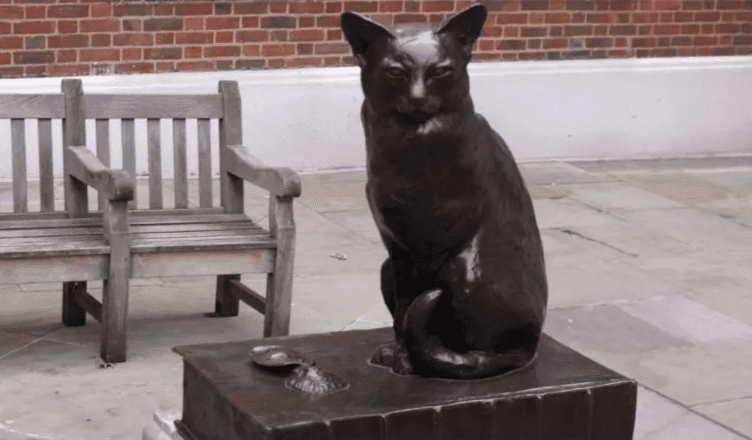There’s nothing I love better on a vacation than finding a surprise. Hidden away from the main tourist routes, there is a small oasis of history and tranquility in the heart of the city. Someone pointed out Dr. Samuel Johnson’s house to me, which was interesting, but the next detail was much more fun. Facing the windows of the writer’s house was the statue of a famous cat.
The statue was of Hodge, a cat owned by the renowned 18th-century writer and lexicographer Dr. Samuel Johnson. For those who may not know, Dr. Johnson is best known for his Dictionary of the English Language, published in 1755, which significantly impacted English lexicography.
Not Just Any Cat. A Famous Cat.
Hodge isn’t just any cat—he holds a special place in the history of English literature. Dr. Johnson, who lived just a stone’s throw away in what is now the Dr. Johnson’s House Museum, was known for his affection for Hodge. The story goes that Johnson personally bought oysters for Hodge, even though they were a luxury food at the time. Now, this statue immortalizes this famous cat, and Johnson’s small gesture shows just how much he cares for his feline friend.
As I stood there, looking at Hodge’s statue, I noticed the little details that made it special. Sculpted by Jon Bickley and unveiled in 1997, the bronze statue shows Hodge sitting atop a large copy of Johnson’s dictionary with a couple of oyster shells by his paws. There’s an inscription that reads, “A very fine cat indeed,” which is a quote attributed to Johnson.
I don’t know about you, but when I find out historical figures owned pets and had an affection for them, it makes them seem a little more human. It creates a connection to the past that doesn’t make the people in it seem so remote. Seeing Hodge immortalized in bronze in Gough Square felt like a delightful peek into Dr. Johnson’s personal life. The square itself, with its cobblestone paths and historic buildings, seems like the perfect place for such a tribute.
Visit Dr. Johnson’s House Museum
After visiting Hodge’s statue, I decided to explore Dr. Johnson’s house, which is now a museum. Walking through the rooms where Johnson lived and worked, I could imagine him bustling about, perhaps with Hodge winding through his legs, mewing for a treat. The museum is filled with fascinating exhibits about Johnson’s life and works that provide a deeper understanding of his contributions to English literature.
A visit to Gough Square reminds us that the often-overlooked details make history so rich and interesting. Next time you’re in London, I highly recommend visiting Hodge and learning more about Dr. Samuel Johnson—and maybe even finding a new favorite spot in the city.






